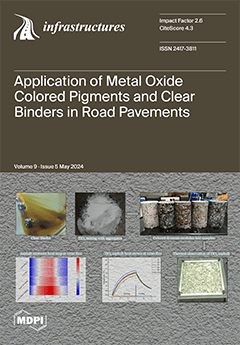This research utilizes the Long-Term Pavement Performance database, focusing on devel-oping a predictive model for flexible pavement performance in the Southern United States. Analyzing 367 pavement sections, this study investigates crucial factors influencing asphaltic concrete (AC) pavement deterioration, such as structural and material
[...] Read more.
This research utilizes the Long-Term Pavement Performance database, focusing on devel-oping a predictive model for flexible pavement performance in the Southern United States. Analyzing 367 pavement sections, this study investigates crucial factors influencing asphaltic concrete (AC) pavement deterioration, such as structural and material components, air voids, compaction density, temperature at laydown, traffic load, precipitation, and freeze–thaw cycles. The objective of this study is to develop a predictive machine learning model for AC pavement wheel path cracking (
WpCrAr) and the age at which cracking initiates (
WpCrAr) as performance indicators. This study thoroughly investigated three ensemble machine learning models, including random forest, extremely randomized trees (ETR), and extreme gradient boosting (XGBoost). It was observed that XGBoost, optimized using Bayesian methods, emerged as the most effective among the evaluated models, demonstrating good predictive accuracy, with an R
2 of 0.79 for
WpCrAr and 0.92 for AgeCrack and mean absolute errors of 1.07 and 0.74, respectively. The most important features influencing crack initiation and progression were identified, including equivalent single axle load (ESAL), pavement age, number of layers, precipitation, and freeze–thaw cycles. This paper also showed the impact of pavement material combinations for base and subgrade layers on the delay of crack initiation.
Full article





